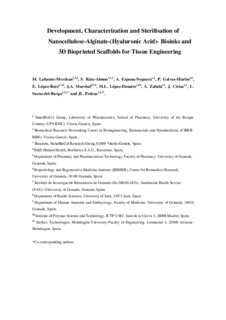| dc.contributor.author | Zabala, Alaitz | |
| dc.contributor.other | Lafuente Merchan, M. | |
| dc.contributor.other | Ruiz Alonso, S. | |
| dc.contributor.other | Espona Noguera, A. | |
| dc.contributor.other | Galvez Martin, Patricia | |
| dc.contributor.other | López Ruiz, E. | |
| dc.contributor.other | Marchal, J.A. | |
| dc.contributor.other | López Donaire, M.L. | |
| dc.contributor.other | Ciriza, J. | |
| dc.contributor.other | Saenz del Burgo, L. | |
| dc.contributor.other | Pedraz, J.L. | |
| dc.date.accessioned | 2022-11-11T09:41:52Z | |
| dc.date.available | 2022-11-11T09:41:52Z | |
| dc.date.issued | 2021 | |
| dc.identifier.issn | 0928-4931 | en |
| dc.identifier.other | https://katalogoa.mondragon.edu/janium-bin/janium_login_opac.pl?find&ficha_no=163591 | en |
| dc.identifier.uri | https://hdl.handle.net/20.500.11984/5835 | |
| dc.description.abstract | 3D-bioprinting is an emerging technology of high potential in tissue engineering (TE), since it shows effective control over scaffold fabrication and cell distribution. Biopolymers such as alginate (Alg), nanofibrillated cellulose (NC) and hyaluronic acid (HA) offer excellent characteristics for use as bioinks due to their excellent biocompatibility and rheological properties. Cell incorporation into the bioink requires sterilisation assurance, and autoclave, β-radiation and γ-radiation are widely used sterilisation techniques in biomedicine; however, their use in 3D-bioprinting for bioinks sterilisation is still in their early stages. In this study, different sterilisation procedures were applied on NC-Alg and NC-Alg-HA bioinks and their effect on several parameters was evaluated. Results demonstrated that NC-Alg and NC-Alg-HA bioinks suffered relevant rheological and physicochemical modifications after sterilisation; yet, it can be concluded that the short cycle autoclave is the best option to sterilise both NC-Alg based cell-free bioinks, and that the incorporation of HA to the NC-Alg bioink improves its characteristics. Additionally, 3D scaffolds were bioprinted and specifically characterized as well as the D1 mesenchymal stromal cells (D1-MSCs) embedded for cell viability analysis. Notably, the addition of HA demonstrates better scaffold properties, together with higher biocompatibility and cell viability in comparison with the NC-Alg scaffolds. Thus, the use of MSCs containing NC-Alg based scaffolds may become a feasible tissue engineering approach for regenerative medicine. | en |
| dc.description.sponsorship | Gobierno Vasco-Eusko Jaurlaritza | es |
| dc.description.sponsorship | Gobierno de España | es |
| dc.language.iso | eng | en |
| dc.publisher | Elsevier | en |
| dc.rights | © 2021 Elsevier Ltd | en |
| dc.subject | 3D-bioprinting | en |
| dc.subject | Sterilisation | en |
| dc.subject | bioinks | en |
| dc.subject | tissue engineering | en |
| dc.title | Development, characterization and sterilisation of Nanocellulose-alginate-(hyaluronic acid)- bioinks and 3D bioprinted scaffolds for tissue engineering | en |
| dcterms.accessRights | http://purl.org/coar/access_right/c_f1cf | en |
| dcterms.source | Materials Science and Engineering C | en |
| local.contributor.group | Tecnologías de superficies | es |
| local.description.peerreviewed | true | en |
| local.identifier.doi | https://doi.org/10.1016/j.msec.2021.112160 | en |
| local.relation.projectID | info:eu-repo/grantAgreement/GV/Ayudas para apoyar las actividades de grupos de investigación del sistema universitario vasco Grupos Consolidados (EHU)/IT907-16/CAPV// | en |
| local.relation.projectID | . | en |
| local.embargo.enddate | 2023-07-31 | |
| local.contributor.otherinstitution | https://ror.org/000xsnr85 | es |
| local.contributor.otherinstitution | https://ror.org/01gm5f004 | es |
| local.contributor.otherinstitution | Bioaraba | es |
| local.contributor.otherinstitution | https://ror.org/057p4eb38 | es |
| local.contributor.otherinstitution | https://ror.org/04njjy449 | es |
| local.contributor.otherinstitution | https://ror.org/0122p5f64 | es |
| local.contributor.otherinstitution | https://ror.org/00bzgd159 | es |
| local.source.details | Vol. 126. N. artículo 112160. July, 2021 | en |
| oaire.format.mimetype | application/pdf | |
| oaire.file | $DSPACE\assetstore | |
| oaire.resourceType | http://purl.org/coar/resource_type/c_6501 | en |
| oaire.version | http://purl.org/coar/version/c_ab4af688f83e57aa | en |







